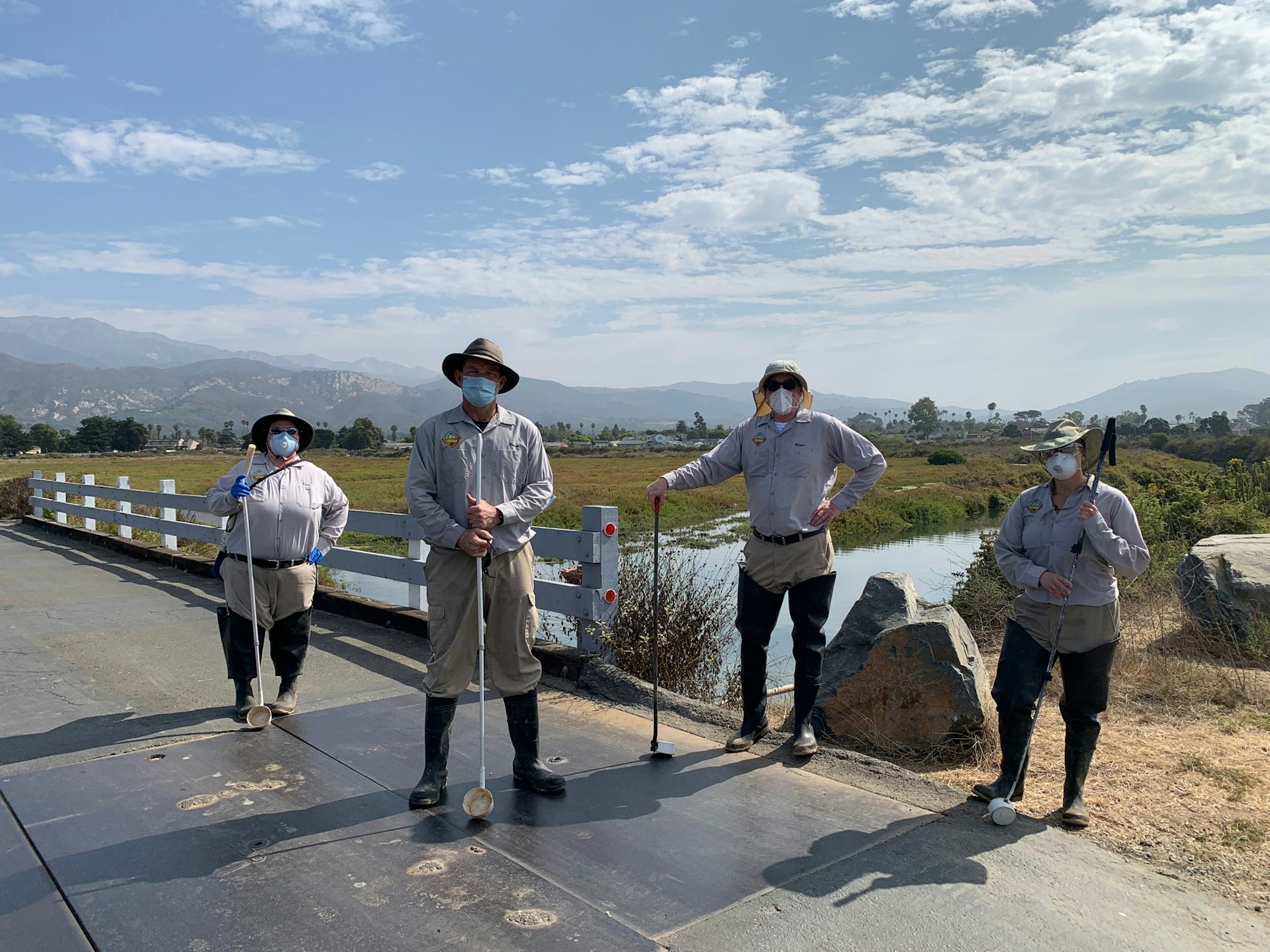Mosquito activity spikes in our local saltwater marshes
At the end of July and continuing into August of 2022, the Mosquito & Vector Management District (MVMD) received many reports of aggressive mosquitoes from residents living near the Goleta Slough. The MVMD was hard at work to address this problem by inspecting and treating well-known mosquito breeding sites. Unseen breeding sites which form in vast locations, like the marsh basins at the Santa Barbara Airport, are often suspected after reports of mosquitoes made by the public prior to our scheduled visits to the marsh.
We received numerous calls and e-mails about mosquitoes from areas in the vicinity of the Goleta Slough (which begins at the ocean west of the Goleta Beach pier, winds its way under Highway 217 and continues between UCSB and the Santa Barbara Airport) . After just a few calls our experienced vector control technicians knew very well that the Goleta Slough likely was the epicenter of the spike in mosquitoes and the Black Salt Marsh mosquito was the culprit.


No other mosquito in our local region gets both residents and technicians as animated like the Black Salt Marsh Mosquito (scientific name: Aedes taeniorhynchus). As one MVMD technician says:
“One Black Salt Marsh Mosquito chasing you feels like you have 20 mosquitoes on you - they are relentless!”
Technicians working in our coastal saltwater marshes over several days still managed to get a few bites even though they wore long pants and long-sleeved shirts and used repellant. Mosquitoes even hitched rides in their trucks with some sitting duck drivers getting a few more bites as they drove out of the slough. The MVMD also placed mosquito traps in the area and the mosquitoes continued to harass technicians as they set out the traps. Over 1,400 mosquitoes were captured.
Click on the link below for more information about mosquito traps:
Mosquito Traps
Our dedicated technicians certainly are a prime example of the phrase, “No pain, no gain!” They pushed through the biting frenzy and were able to zero in on and begin treating new breeding sites. By the end of August, the residents along the areas of the Goleta Slough were able to get relief from the surge in mosquito activity. Hurray Team Vector!!

When is the Black Salt Marsh Mosquito active in our local saltwater marshes?
This mosquito is notorious for being very active during summer. Their behavior is aggressive, and some might call it “unfriendly” since it likes to dine at our expense.
- Scientific name: Aedes taeniorhynchus (pronounced "A-dees tay-nee-oh-reen or ryn-kuss")
- Agressive day and night biter
- Breeds in brackish (saltier than freshwater but not as salty as sea water) and salt water during the summer
- Produces multiple generations of mosquitoes in the summer
- Can fly up to 5 miles in search of a blood meal
- Proboscis (needle-like mouthparts) has a white band around it and the body has a tapering, pointed end
- Like other mosquito species, only the female feeds on blood (needed for producing eggs).
- Males feed exclusively on nectar. Females can also feed on nectar.

A wise owl at the MVMD once figured out that when the Carpinteria and Goleta saltwater marshes became inundated after high tides of 6 feet or more, those wetlands became mosquito hatcheries for the Black Salt Marsh Mosquito. On average, 3-6 days after a 6 foot or higher tide the mosquito eggs hatch. The District will then use appropriate methods for control when numerous mosquito larvae are visible in the water.
Do all areas of the marshlands breed mosquitoes?
No. Breeding only occurs in areas that pool water after high tides. In other words, after the tide recedes, those areas with a “tea cup” depression in the ground do not drain and will hold enough stagnant water for the mosquito life cycle to be completed.

Fortunately, not all of these sites breed mosquitoes. We routinely check those that historically breed and treat them as needed. Unfortunately, it is difficult to know when new ones become breeding sites. When the public living in areas near marshlands notifies the MVMD about a huge spike in mosquitoes it signals to us that new breeding sites are the likely reason. Public reports of increased mosquito activity are informative and alert us to begin looking for undetected breeding sites and to reassess our approach to monitoring the marshlands.
What changes occur in the marshlands to create more mosquito breeding sites?
- The flow of tides in the marshlands can bring significant modifications through erosion, creating sand berms as the result of sedimentation, and increasing the accumulation of or removal of debris. Storm surges can have similar impacts within a much shorter time span.
- Rainfall and flash floods can also cause erosion, mud and debris accumulation and removal, and increased pooling of water in marshes.
- Fault lines running under marshlands can subside, lift or split the marsh basin.
- Human activity can have positive or negative impacts. For example, marsh restoration projects help re-establish proper inflow and outflow of water during tides. On a smaller scale, footprints in the mud can have a negative effect by creating depressions that collect water.
- An increase in the sea level will cause more flooding in marshlands.


